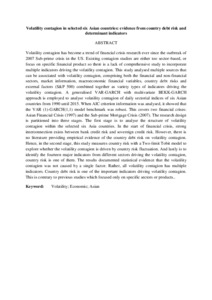Citation
Lee, See-Nie and Cheng, Fan-Fah and Hooy, Chee-Wooi and Yahya, Mohamed Hisham Dato Haji
(2017)
Volatility contagion in selected six Asian countries: evidence from country debt risk and determinant indicators.
International Journal of Business and Administrative Studies, 3 (2).
pp. 36-55.
ISSN 2414-3081
Abstract
Volatility contagion has become a trend of financial crisis research ever since the outbreak of 2007 Sub-prime crisis in the US. Existing contagion studies are either too sector-based, or focus on specific financial product so there is a lack of comprehensive study to incorporate multiple indicators driving the volatility contagion. This study analysed multiple sources that can be associated with volatility contagion, comprising both the financial and non-financial sectors, market information, macroeconomic financial variables, country debt risks and external factors (S&P 500) combined together as variety types of indicators driving the volatility contagion. A generalised VAR-GARCH with multivariate BEKK-GARCH approach is employed to analyse volatility contagion of daily sectorial indices of six Asian countries from 1990 until 2015. When AIC criterion information was analysed, it showed that the VAR (1)-GARCH(1,1) model benchmark was robust. This covers two financial crises: Asian Financial Crisis (1997) and the Sub-prime Mortgage Crisis (2007). The research design is partitioned into three stages. The first stage is to analyse the structure of volatility contagion within the selected six Asia countries. In the start of financial crisis, strong interconnection exists between bank credit risk and sovereign credit risk. However, there is no literature providing empirical evidence of the country debt risk on volatility contagion. Hence, in the second stage, this study measures country risk with a Two-limit Tobit model to explore whether the volatility contagion is driven by country risk fluctuation. And lastly is to identify the fourteen major indicators from different sectors driving the volatility contagion, country risk is one of them. The results documented statistical evidence that the volatility contagion was not caused by a single factor. Rather, all volatility contagion has multiple indicators. Country debt risk is one of the important indicators driving volatility contagion. This is contrary to previous studies which focused only on specific sectors or products.
Download File
![[img]](http://psasir.upm.edu.my/63694/1.hassmallThumbnailVersion/Volatility%20contagion%20in%20selected%20six%20Asian%20countries.pdf)  Preview |
|
Text (Abstract)
Volatility contagion in selected six Asian countries.pdf
Download (5kB)
| Preview
|
|
Additional Metadata
Actions (login required)
 |
View Item |

